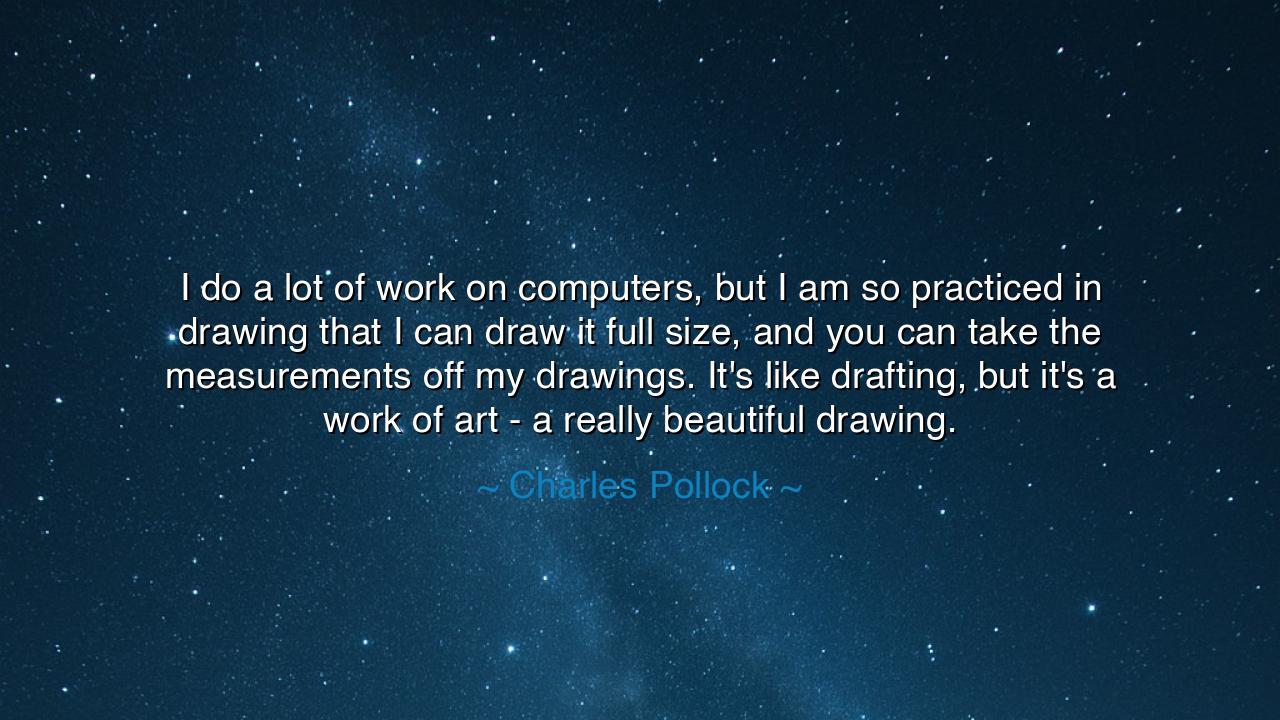
I do a lot of work on computers, but I am so practiced in drawing
I do a lot of work on computers, but I am so practiced in drawing that I can draw it full size, and you can take the measurements off my drawings. It's like drafting, but it's a work of art - a really beautiful drawing.






The designer and craftsman Charles Pollock, a man whose hands shaped both steel and beauty, once said: “I do a lot of work on computers, but I am so practiced in drawing that I can draw it full size, and you can take the measurements off my drawings. It's like drafting, but it's a work of art—a really beautiful drawing.” These words speak not merely of skill, but of mastery—the sacred union between hand and mind, between craft and creation. In his reflection, Pollock reveals the eternal truth that technology may assist the artist, but it is the human touch that gives form its soul. The computer can calculate, but only the heart can compose.
In the ancient world, the masters of creation were not divided between art and science. The architects of Greece, the sculptors of Egypt, the designers of Rome—they were artisans of both beauty and precision. The same hand that sketched the columns of the Parthenon also calculated their proportions. In their drawings, mathematics and imagination were as one. Pollock, though a child of the modern age, carried this same spirit. His drawing, precise enough to serve as a blueprint, yet alive enough to stir emotion, stands as proof that true artistry bridges the worlds of function and inspiration.
When Pollock says, “It's like drafting, but it's a work of art,” he teaches that even the most technical act can become art when performed with passion and excellence. To the untrained eye, a technical drawing is lines and angles; to the master, it is rhythm and harmony. Each stroke of the pencil becomes a note in the symphony of design. The ancients would have called this techne, the sacred craft through which the divine expresses itself in human work. Whether carving marble or sketching steel, the true craftsman channels not mere skill, but reverence.
The origin of Pollock’s wisdom lies in his life’s devotion to design—particularly in his work shaping the modern form of furniture. In an age when the world turned increasingly toward machines, he held fast to the belief that craftsmanship remained the beating heart of creation. Computers could assist, yes, but they could not replace the instinct that comes from years of drawing, touching, and building with one’s own hands. His full-sized sketches were not mere plans—they were acts of communion between imagination and reality. His line was sure, because his mind had already built what his hand revealed.
Consider the story of Leonardo da Vinci, who filled his notebooks with inventions that would not be built for centuries. His sketches of flying machines, bridges, and human anatomy were both scientific studies and works of art—so beautiful that they still inspire wonder today. Leonardo, like Pollock, did not draw merely to record; he drew to understand. His drawings lived as both instruction and inspiration. They were blueprints that breathed, designs that dreamed. In every curve of ink, he demonstrated the principle Pollock later echoed: that drafting and artistry are not separate paths, but two faces of the same discipline.
There is a deeper lesson here for our own time. The world now rests in the hands of machines—programs that calculate faster, draw cleaner, and render in perfect symmetry. Yet, as Pollock reminds us, perfection without humanity is emptiness. The line drawn by hand carries something the machine cannot—imperfection, yes, but also life. It bears the slight tremor of thought, the echo of breath, the spark of feeling. To rely only on computers is to risk forgetting that creation is not only an act of building, but an act of being. The tools may evolve, but the artist’s soul must remain at the center.
So let the wise hear and understand: whatever your craft, do not surrender your hands to automation nor your heart to ease. Use the tools of the age, but do not let them master you. Practice your art until your body itself remembers its language—until you can, like Pollock, draw the shape of your vision as though it already exists in the world. Cultivate discipline until precision becomes second nature, and passion until your precision becomes beautiful.
For in the end, Charles Pollock’s words remind us that true mastery is not found in the tool, but in the soul that wields it. A computer may render a perfect line, but only the human being can infuse it with meaning. So let every builder, artist, and creator strive for this harmony: to blend the precision of technology with the warmth of humanity, to make even the simplest drawing a reflection of wonder. For when craft and spirit meet, every plan becomes poetry, and every drawing, however practical, becomes—a work of art.






AAdministratorAdministrator
Welcome, honored guests. Please leave a comment, we will respond soon